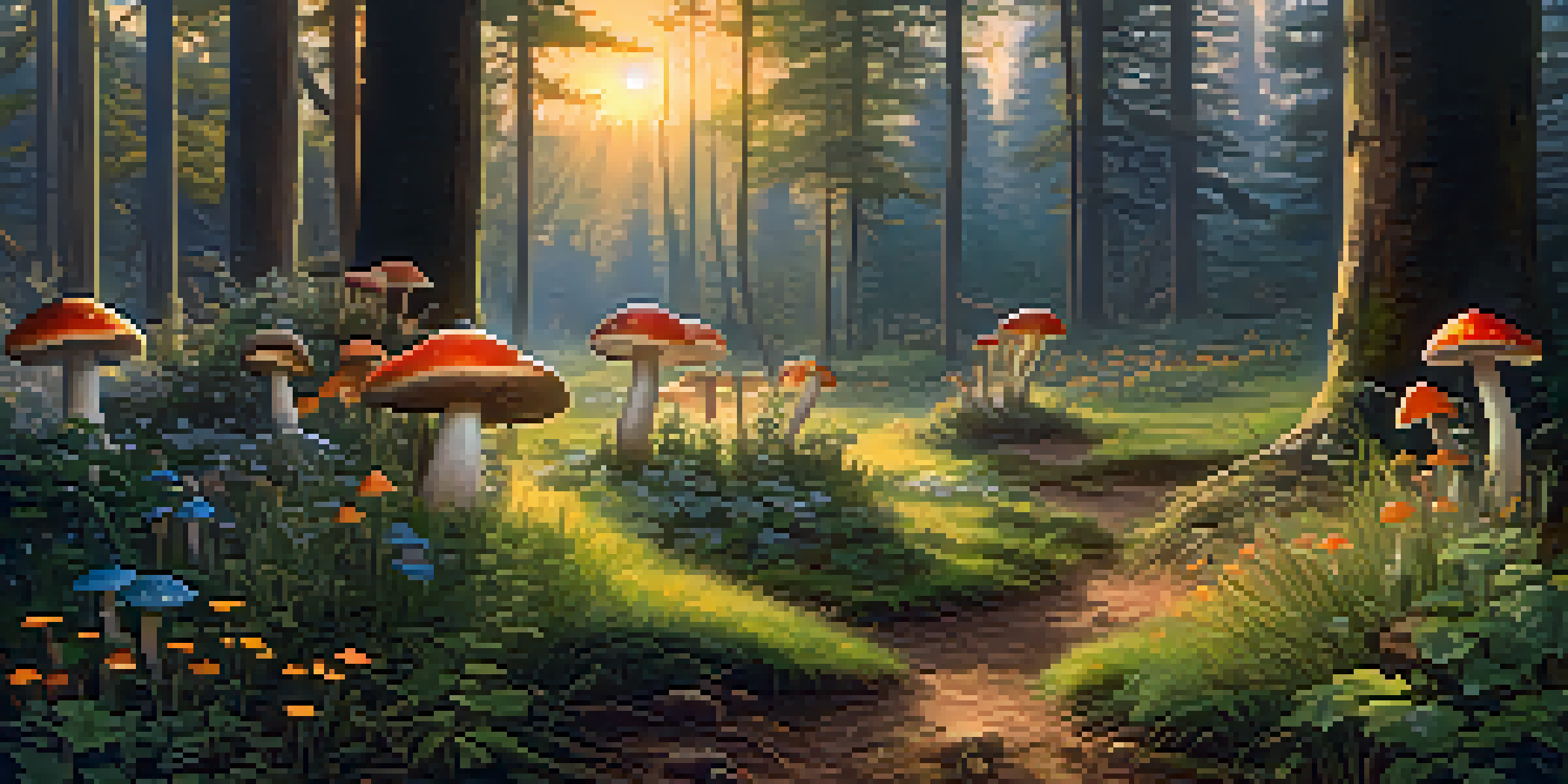Entheogens and Mystical Experiences: A Comparative Study

What Are Entheogens and Their Role in Mystical Experiences?
Entheogens are substances, often derived from plants, that have been used for centuries in various cultures to induce spiritual or mystical experiences. These substances, like psilocybin mushrooms or ayahuasca, can alter perception, enhance emotional experiences, and offer insights into one’s consciousness. People often seek these experiences for healing, personal growth, or a deeper connection with the universe.
The experience of mystical states is often a profound sense of unity and connectedness with all that exists.
The term 'entheogen' itself means 'generating the divine within,' highlighting the belief that these substances can facilitate profound spiritual encounters. Many users report feelings of unity with nature, deep insights into their lives, and a sense of connection to something greater than themselves. This transformative potential makes entheogens a fascinating subject of study in the realm of spirituality and psychology.
Throughout history, various religious and spiritual traditions have incorporated entheogenic practices as a means to explore the sacred. From ancient shamanic rituals to modern therapeutic practices, these experiences often leave lasting impacts on individuals, reshaping their beliefs and behaviors. Understanding this relationship is crucial for appreciating how entheogens contribute to mystical experiences.
Historical Context: Entheogens in Ancient Cultures
The use of entheogens can be traced back to ancient civilizations, where they played a pivotal role in religious ceremonies and rituals. For instance, the Aztecs utilized peyote in their spiritual practices, believing it connected them to their gods. Similarly, the ancient Greeks reportedly consumed kykeon, a drink that may have contained hallucinogenic properties, during the Eleusinian Mysteries, seeking divine revelations.

These historical examples highlight the widespread belief in the power of entheogens to facilitate contact with the divine. Many indigenous cultures view these substances as sacred tools for healing, divination, and personal transformation. This rich tapestry of usage sets the stage for exploring how these practices influence mystical experiences across different societies.
Entheogens Foster Spiritual Growth
Entheogens can induce profound mystical experiences that promote healing, personal growth, and a deeper connection to the universe.
By examining the historical context, we can gain insights into how these ancient practices laid the foundation for contemporary understandings of spirituality. The reverence for entheogens in these cultures underscores their importance not just as substances, but as integral components of spiritual life, shaping the quest for enlightenment and understanding.
Modern Research on Entheogens and Mystical Experiences
In recent years, there has been a resurgence of interest in the scientific study of entheogens and their effects on consciousness. Researchers are exploring how substances like LSD, psilocybin, and ayahuasca can facilitate mystical experiences, offering insights into the brain's workings and our perception of reality. This modern inquiry seeks to bridge ancient wisdom with contemporary science, providing a holistic understanding of these powerful substances.
Entheogens are not simply substances; they are sacred tools that can help us explore the depths of our consciousness.
Studies have shown that entheogens can significantly alter brain activity, often leading to experiences characterized by feelings of transcendence, unity, and interconnectedness. Participants in clinical trials often report long-lasting changes in their attitudes, behaviors, and overall well-being following these experiences. Such findings support the idea that entheogens are not merely recreational substances but can serve as catalysts for profound personal transformation.
Moreover, the therapeutic potential of entheogens is gaining recognition in treating mental health issues such as depression, anxiety, and PTSD. As research continues to unfold, it becomes increasingly clear that understanding the relationship between entheogens and mystical experiences could pave the way for innovative approaches to healing and self-discovery.
Comparing Mystical Experiences Across Different Entheogens
Different entheogens can elicit varying types of mystical experiences, each unique in its effects and the insights it can provide. For instance, users of psilocybin mushrooms often report vivid visual hallucinations and a sense of euphoria, while ayahuasca, a potent brew from the Amazon, may lead to a more introspective journey that often involves confronting personal traumas. These distinctions highlight how the specific chemical composition of each entheogen influences the nature of the experience.
Additionally, the setting and mindset play crucial roles in shaping these experiences. A serene, supportive environment can enhance feelings of safety and connectedness, while a chaotic or uncomfortable setting may lead to anxiety or challenging experiences. This interplay between the substance, the individual, and their context is essential for understanding the diversity of mystical experiences.
Historical Use in Ancient Cultures
Various ancient civilizations utilized entheogens in religious rituals, believing they facilitated contact with the divine and personal transformation.
By comparing the effects of various entheogens, we gain insight into the universal themes that emerge, such as feelings of unity, transcendence, and insight. These common threads suggest that regardless of the specific substance used, entheogens can guide individuals on a journey of self-exploration and spiritual awakening.
The Psychological Impact of Mystical Experiences
Mystical experiences induced by entheogens can have profound psychological impacts, often leading to lasting changes in one’s worldview. Participants frequently describe feelings of interconnectedness and a diminished sense of ego, which can foster a greater appreciation for life and the natural world. These shifts in perception can enhance emotional resilience and overall mental well-being.
Moreover, many individuals report that these experiences provide clarity regarding their life purpose or relationships, often prompting significant changes in behavior. For example, someone might feel inspired to pursue a creative passion or mend a strained relationship after a transformative experience. This potential for personal growth underscores the therapeutic value of entheogens in promoting mental health.
However, it’s essential to approach these experiences with caution, as not everyone reacts positively to entheogens. Some may encounter challenging emotions or memories during their journeys, which can be overwhelming. Understanding the psychological implications of mystical experiences is crucial for ensuring that individuals can navigate these journeys safely and meaningfully.
Cultural Perspectives on Entheogens and Spirituality
Cultural perspectives on entheogens vary widely, influencing how they are perceived and used in spiritual practices. In many indigenous cultures, entheogens are regarded as sacred gifts from nature, integral to rituals aimed at healing, community bonding, and spiritual exploration. These practices emphasize respect for the substances and the experiences they facilitate, highlighting a deep-rooted understanding of their significance.
In contrast, modern Western societies often approach entheogens with skepticism, viewing them primarily through a medical or recreational lens. This dichotomy raises important questions about the role of cultural context in shaping our understanding of spirituality and consciousness. Bridging these perspectives can foster greater appreciation for the wisdom embedded in traditional practices.
Modern Research Validates Benefits
Recent studies reveal that entheogens can significantly alter brain activity and contribute to lasting changes in mental health and well-being.
As the global interest in entheogens grows, so does the need for respectful dialogue between cultures. Engaging with diverse perspectives can enrich our understanding of entheogens and their potential to enhance spiritual experiences, ultimately fostering a more holistic view of spirituality that honors both ancient traditions and contemporary insights.
The Future of Entheogens in Spiritual and Therapeutic Contexts
The future of entheogens in both spiritual and therapeutic contexts looks promising, as ongoing research continues to unveil their potential benefits. With increasing acceptance in scientific and medical communities, we may see more structured programs that integrate entheogens into therapeutic practices, offering individuals a chance for profound healing and self-discovery. This shift could redefine our approach to mental health and spiritual growth.
Moreover, the rising popularity of entheogenic retreats and guided experiences reflects a growing interest in exploring altered states of consciousness. These retreats provide safe environments for individuals to engage with these substances, often facilitated by experienced guides who can help navigate the complexities of the journey. Such settings can foster community and support, enhancing the overall experience.

As we move forward, it’s crucial to balance enthusiasm for entheogens with responsible usage and a respect for their sacred origins. By fostering informed discussions and practices, we can ensure that entheogens continue to serve as valuable tools for personal and spiritual growth, enriching lives and deepening our understanding of the human experience.